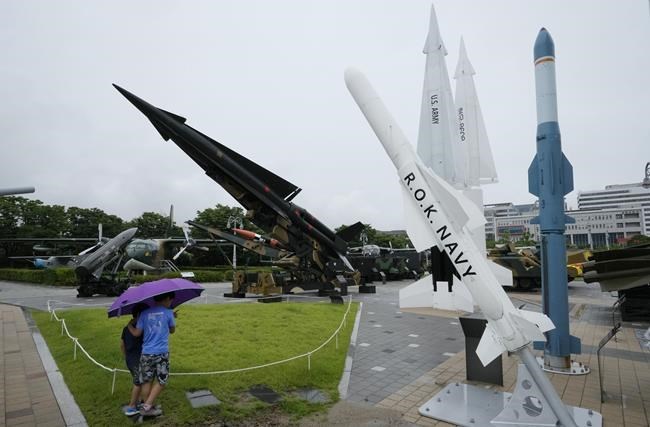SEOUL, Â鶹ĘÓƵ Korea (AP) — North Korea fired two short-range ballistic missiles into the sea Wednesday in what appeared to be a statement of defiance as the United States deployed a nuclear-armed submarine to Â鶹ĘÓƵ Korea for the first time in decades.
The launches came as the U.S. and the U.S.-led United Nations Command worked to resolve the highly unusual situation involving who crossed into North Korea while on a tour of a border village Tuesday afternoon.
Â鶹ĘÓƵ Korea’s Joint Chiefs of Staff said that from 3:30 to 3:46 a.m. North Korea fired two missiles from an area near the capital Pyongyang that flew about 550 kilometers (341 miles) before landing in waters east of the Korean Peninsula.
The Japanese military said the missiles landed outside of Japan’s exclusive economic zone and no damage to ships or aircraft was reported.
The flight distance of the two missiles roughly matched the distance between Pyongyang and the Â鶹ĘÓƵ Korean port city of Busan, where arrived Tuesday afternoon in the first visit by a U.S. nuclear-armed submarine to Â鶹ĘÓƵ Korea since the 1980s.
Japanese Defense Minister Yasukazu Hamada told reporters the missiles flew on a low trajectory, reached about 50 kilometers (31 miles) in altitude and may have made irregular maneuvers in flight. That language has been used in the past to describe a North Korean weapon modeled after Russia’s Iskander missile, which is designed to be maneuverable in flight to improve its chances of evading missile defenses.
The Â鶹ĘÓƵ Korean Joint Chiefs of Staff condemned the North Korean launches as “major provocation” that threatens peace and stability in the region and said the Â鶹ĘÓƵ Korean and U.S. militaries were closely monitoring the North for further weapons activities.
Wednesday’s launches marked the North’s first ballistic activity since July 12, when it flight-tested a new solid-fuel intercontinental ballistic missile that demonstrated potential range to reach deep into the U.S. mainland. That launch was supervised by the country’s , who vowed to further bolster his country’s nuclear-fighting capabilities in the face of expanding U.S.-Â鶹ĘÓƵ Korean military activities, which he blamed for worsening the security environment on the Korean Peninsula.
Tensions have rose in the region in recent months as the pace of both North Korean weapons tests and U.S.-Â鶹ĘÓƵ Korean joint military drills have increased in a cycle of tit-for-tat.
Since the start of 2022, North Korea has test-fired around 100 missiles while attempting to demonstrate a dual ability to conduct nuclear attacks on both Â鶹ĘÓƵ Korea and the continental United States. The allies in response have stepped up their joint military training and agreed to increase the deployments of U.S. strategic assets like long-range bombers, aircraft carriers and submarines to the region.
Periodic visits by U.S. nuclear ballistic missile-capable submarines to Â鶹ĘÓƵ Korea were one of several agreements reached by President Joe Biden and Â鶹ĘÓƵ Korean President Yoon Suk Yeol in response to North Korea’s expanding nuclear threat. They also agreed to further expand combined military exercises, strengthen joint planning for nuclear contingencies and establish a bilateral Nuclear Consultative Group, which held its inaugural meeting in Seoul Tuesday.
The steps were meant to ease Â鶹ĘÓƵ Korean concerns about North Korea's growing nuclear weapons arsenal and suppress voices within the Â鶹ĘÓƵ calling for the country to pursue its own nuclear weapons program.
U.S. Forces Korea said in a statement that the Kentucky's arrival in Busan reflects the United States' “ironclad” commitment to “extended deterrence,” referring to an assurance to defend its ally with its full military capabilities, including nuclear ones.
The Ohio-class submarine can be equipped with about 20 Trident II ballistic missiles with a range of 12,000 kilometers (7,456 miles), according to Â鶹ĘÓƵ Korea's military.
“From this submarine, the U.S. can launch attacks (on North Korea) from anywhere in the world," said Moon Keun-sik, a submarine expert who teaches at Kyonggi University in Â鶹ĘÓƵ Korea. “But there will likely be backlashes from North Korea and China because it’s like the world’s most covert and threatening nuclear weapons forces being deployed on their doorsteps.”
While some Â鶹ĘÓƵ Korean conservatives have expressed disappointment that the Biden-Yoon meeting in April came short of agreeing to station U.S. nuclear weapons or strategic assets in the Â鶹ĘÓƵ, placing nuclear weapons offshore and on submarines is “actually a stronger deterrent in many ways,” said Duyeon Kim, a senior analyst at Washington’s Center for a New American Security.
“Deterrence is strengthened when the location of American strategic assets is unknown to the adversary as long as the adversary knows that these weapons exist,” said Kim.
Still, Seoul and Washington will need to find the “sweet spot” when it comes to the visibility of America’s extended deterrent.
“Too much visibility of strategic assets could actually undermine the deterrent effect while too little could raise questions in Seoul about commitment," Kim said.
___
AP journalists Mari Yamaguchi and Haruka Nuga in Tokyo contributed to this report.
Kim Tong-hyung And Hyung-jin Kim, The Associated Press




